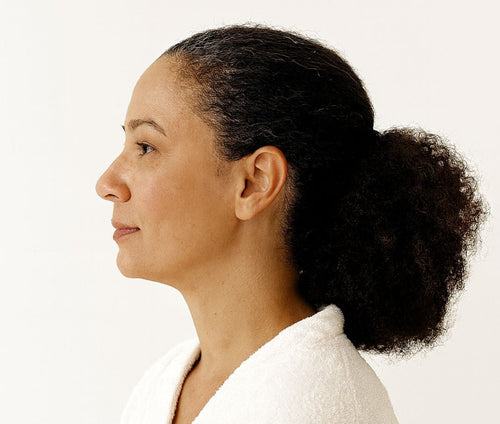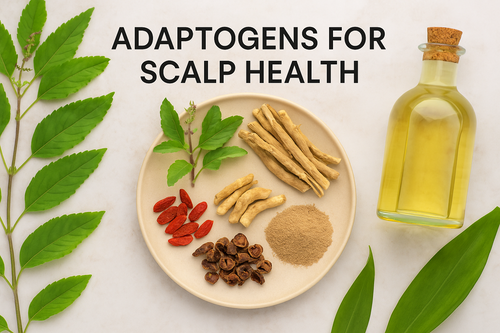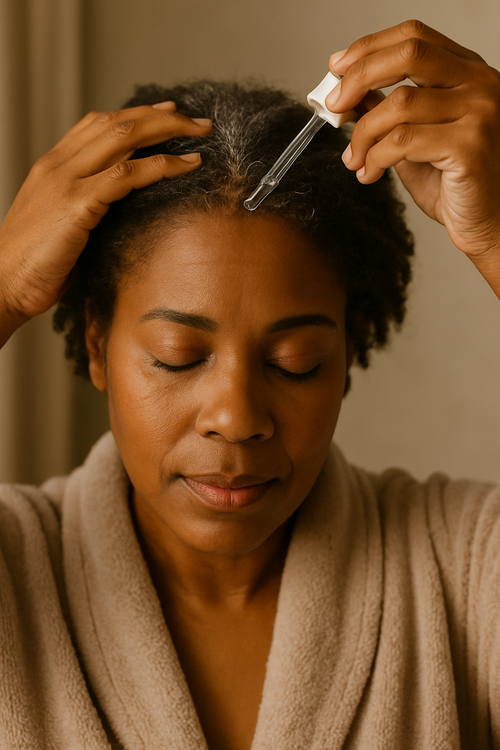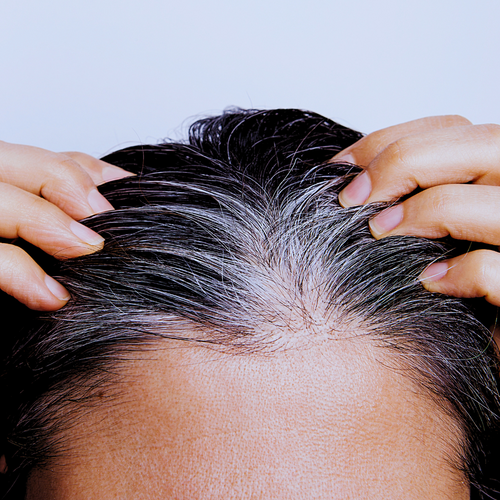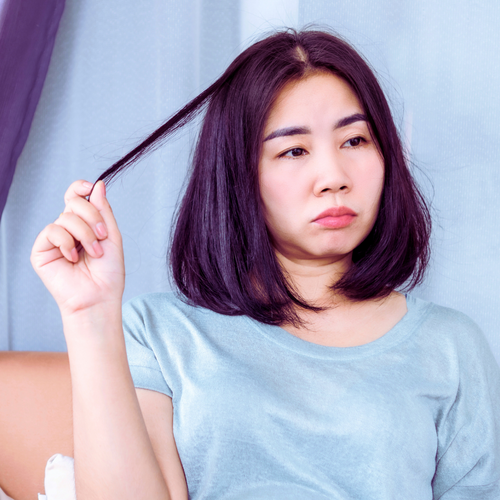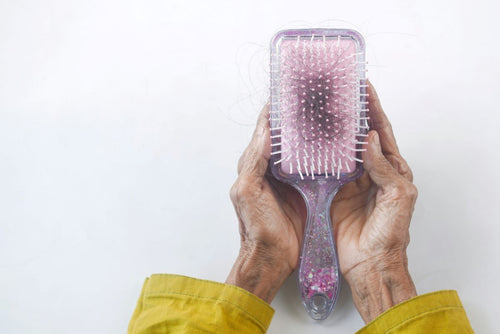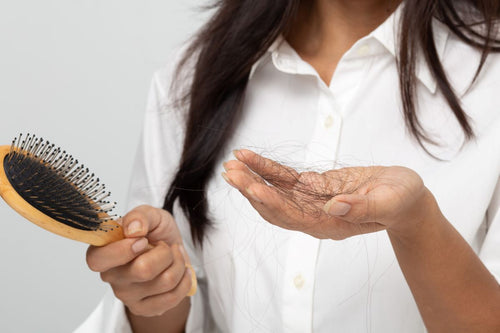Stress isn’t just in your head — it shows up on your skin, your hair, and especially your scalp. For women over 40, stress-driven scalp changes become more common, often showing up as persistent itching, inflammation, or even hair thinning.
This post breaks down how cortisol — your body’s main stress hormone — disrupts scalp health, what midlife women need to know, and how to calm the cycle before it spirals.
Why Stress and Scalp Care Are Connected
Your scalp isn’t just where your hair grows — it’s living skin, with oil glands, nerves, and a protective barrier. Just like facial skin, it responds directly to stress signals from your body.
When stress levels spike:
• Cortisol rises and stays elevated.
• Blood flow slows, so follicles get fewer nutrients.
• Sebum balance shifts, leading to dryness or greasy buildup.
• The barrier weakens, leaving skin prone to irritation.
• Inflammation spreads, making nerves hypersensitive.
In short: stress literally changes your scalp’s environment — and the longer it goes unchecked, the more visible the results become.
The Science of Cortisol and Your Scalp
Cortisol’s Impact on the Skin Barrier
The scalp barrier is your first line of defense. Elevated cortisol breaks it down by disrupting lipid (oil) production, which keeps the scalp hydrated and protected. This can lead to:
• Dry, flaky patches
• Overproduction of oil in some spots
• Greater sensitivity to hair products or environmental triggers
Circulation and Follicle Health
Cortisol also acts as a vasoconstrictor, meaning it narrows blood vessels. That means less oxygen and fewer nutrients reach your follicles, slowing hair growth and making hair feel thinner over time.
Immune System and Inflammation
Stress shifts your immune system into “high alert.” On the scalp, that can look like redness, itching, and flare-ups of conditions like seborrheic dermatitis or psoriasis.
Why Women Over 40 Are More Vulnerable
Estrogen and Cortisol Balance
In your 20s and 30s, estrogen helps regulate cortisol’s effects. But during perimenopause and menopause, estrogen levels decline, giving cortisol more “freedom” to damage tissues.
Visible Midlife Changes
That’s why midlife women often notice:
• A drier, itchier scalp
• More shedding or slow regrowth
• Sensitivity to shampoos or treatments that never bothered them before
Stress + Hormones = Double Impact
Add life stressors (career demands, caregiving, aging parents, teens, relationships) and the result is a perfect storm for scalp stress and visible hair changes.
The Stress–Scalp Cycle
It isn’t just one bad week at work. Stress creates a repeating cycle:
1. Stress → triggers cortisol surge
2. Increased Cortisol → weakens scalp barrier and slows follicle growth
3. Itch & Inflammation → cause discomfort, scratching, flaking
4. Hair Thinning → increases anxiety, leading to more stress
This self-reinforcing loop keeps going until something interrupts it.

How to Break the Stress–Scalp Cycle
Daily Rituals for Calmer Scalps
• Scalp massage: 5 minutes a day of scalp massage reduces cortisol and stimulates circulation.
• Aromatherapy oils: Aromatherapy with oils like neroli, lavender, and rose calm both mind and scalp.
• Adaptogen scalp serums: Help balance the stress response directly at the root.
Nutrition for Resilience
• Magnesium-rich foods - Evaluate your diet. Pumpkin seeds & dark leafy greens help regulate cortisol.
• Polyphenols & antioxidants - (green tea, berries, turmeric) fight inflammation.
• Stay hydrated — dehydration amplifies stress impact on skin and scalp.
Mind–Body Practices
• Breathwork: Even 3 minutes of slow breathing lowers cortisol.
• Yoga & meditation: Yoga can reduce both stress and inflammatory pathways.
• Sleep hygiene: Cortisol normalizes when circadian rhythms are steady.
Adaptogens for Scalp Health
Adaptogenic herbs like ashwagandha, holy basil, and schisandra are used to help regulate cortisol and reduce oxidative stress. When used in scalp serums or teas, they address both the internal and external effects of stress.
The Gut–Skin–Scalp Connection
Stress doesn’t just hit the scalp directly — it also disrupts the gut microbiome. That imbalance increases systemic inflammation, which can show up as:
• More frequent scalp itching or flaking
• Slower healing of irritation
• Aggravation of conditions like seborrheic dermatitis
Supporting gut health with probiotic foods, fiber, and stress management creates a healthier environment for your scalp.
Lifestyle Habits That Protect Your Scalp
• Set boundaries: Overcommitment fuels chronic cortisol.
• Movement: Regular exercise reduces stress reactivity and boosts circulation.
• Digital detox: Screen time late at night disrupts sleep and cortisol rhythms.
• Nature therapy: Even 15 minutes outside lowers cortisol.
FAQs on Stress and Scalp Care
Can stress cause permanent hair loss?
Usually, stress-related thinning is temporary. Once stress is managed, hair growth often rebounds within months.
Does stress cause dandruff?
Indirectly. Stress worsens oil imbalance and weakens barrier defenses, which can trigger dandruff flares.
What’s the difference between stress itch and other scalp conditions?
Stress itch usually comes with periods of anxiety or life stress and may improve with relaxation rituals, while conditions like psoriasis are chronic.
Can adaptogens really help scalp stress?
Yes. Adaptogens like ashwagandha regulate cortisol, reduce inflammation, and can soothe stressed scalps when used in serums or teas.
How long does it take to see improvement?
Most people notice less itch and irritation in 4–6 weeks of consistent rituals. Hair thickness may improve within 3–6 months.
Is scratching harmful?
Yes — scratching disrupts the skin barrier, triggers more inflammation, and may damage follicles.


